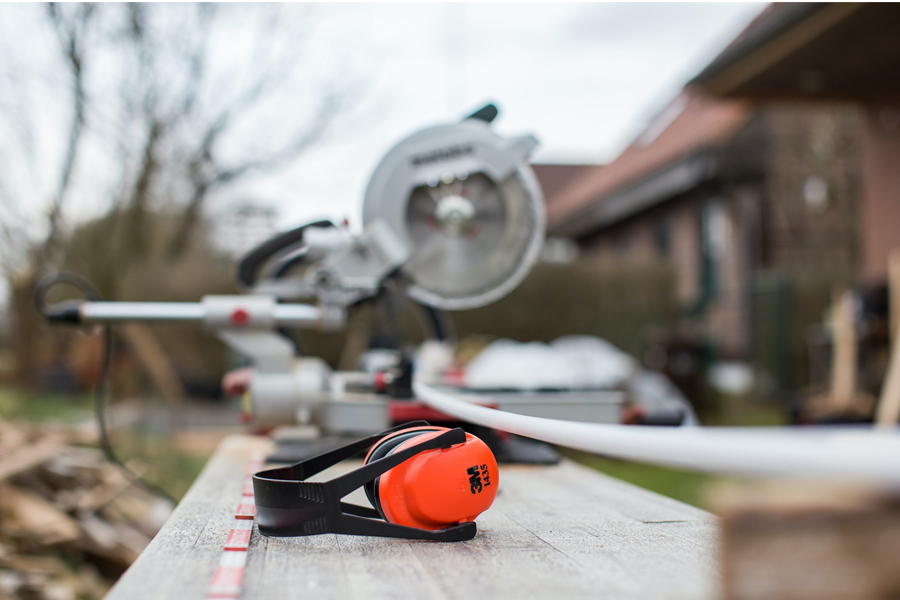
Just like you protect your eyes with safety glasses, noise-cancelling protection, such as earmuffs or earplugs, can have a significant impact on overall communication and safety in noisy environments. In terms of communication, ear protection can make it easier for people to hear and understand one another in loud environments. This can be especially important in situations where clear communication is critical, such as in construction sites, factories, or on the shooting range. In these environments, loud noise can make it difficult for workers to hear and understand one another, which can lead to miscommunication and mistakes. In terms of safety, ear protection can help to reduce the risk of noise-induced hearing loss (NIHL) and tinnitus. This becomes particularly crucial in environments where workers face regular exposure to loud noise.
Additionally, ear protection can also help to reduce the overall noise level in the environment. It makes it easier for people to concentrate and stay alert. This can be especially important in environments where loud noise can be distracting and can lead to mistakes.
In this article, we’ll explore the different types of noise-cancelling earmuffs available, how they work, and the benefits they offer in various settings. We’ll also provide tips for choosing the right earmuffs for your needs and how to properly wear and care for them. With the right ear protection, you can enjoy all the sights and sounds of life without putting your hearing at risk.
The Dangers of Noise-Induced Hearing Loss and How Noise-Cancelling Earmuffs Can Prevent It
Noise-induced hearing loss (NIHL) is a type of hearing loss caused by prolonged exposure to loud noise. It can occur gradually over time or suddenly from a single loud noise event. NIHL is permanent and its not reversible. Some common causes of NIHL include working in loud environments (such as construction sites, factories, or airports), attending loud concerts or sporting events, and using power tools or firearms.
The dangers of NIHL include difficulty hearing in noisy environments, trouble understanding speech, and tinnitus (ringing in the ears). NIHL can also lead to social isolation and depression.
Ear protection, such as earmuffs or earplugs, can help prevent NIHL by reducing the amount of sound that enters the ear. Earmuffs work by physically blocking sound waves, while earplugs work by reducing the amount of sound that enters the ear canal. Both types of ear protection can be highly effective in reducing noise levels and protecting hearing. It’s also important to note that you should use ear protection along with avoiding loud noise when possible, and limiting the amount of time spent in loud environments.
Types of Ear Protection
There are two main types of ear protection: passive and active.
Passive ear protection, also known as noise-blocking or noise-attenuating earmuffs, works by physically blocking sound waves with a barrier. This type of ear protection is typically made of a material that absorbs sound, such as foam or plastic. Passive earmuffs are usually inexpensive and simple to use, but they can be bulky and can be uncomfortable to wear for long periods. They are also not effective in blocking all types of noise, especially low-frequency sounds.
Active noise-cancelling earmuffs, on the other hand, use electronic technology to actively reduce noise. They have a microphone that picks up ambient noise and generates sound waves that are the opposite, or “negative,” of the ambient noise. These sound waves cancel out the noise, reducing the overall noise level. Active noise-cancelling earmuffs are more effective at blocking low-frequency sounds and can be more comfortable to wear for long periods. They are also more expensive than passive earmuffs.
In addition to passive and active earmuffs, earplugs are also a common type of ear protection. They are small devices that insert into the ear canal and block or reduce noise. They can be made of foam, rubber, or silicone and can be disposable or reusable. Moreover, they can be useful when noise is coming from a specific direction or when you need to wear ear protection for a long time.
It’s important to note that different types of ear protection may be more appropriate for certain situations. For example, passive earmuffs may be more suitable for construction sites where noise is constant. On the other hand, active noise-cancelling earmuffs may be more appropriate for an airport where noise comes from different directions.
How Noise-Cancelling Technology Works in Earmuffs
Noise-cancelling technology in earmuffs uses a process called “active noise control” to reduce ambient noise. This process involves the use of microphones and speakers to pick up and analyze ambient noise, and then generate sound waves that are the opposite, or “negative,” of the ambient noise. These sound waves cancel out the noise, reducing the overall noise level.
The process begins with one or more microphones that are built into the earmuffs. These microphones pick up ambient noise and send it to a processor. The processor then analyzes the noise and generates a “negative” sound wave, which is the opposite of the ambient noise. This negative sound wave is then sent to speakers, which are built into the earmuffs.
The speakers then emit the negative sound wave, which travels through the earmuffs and into the ear canal. The ambient noise and the negative sound wave meet inside the earmuffs, where they cancel each other out. This creates a “quiet zone” within the earmuffs, reducing the overall noise level.
Active noise-canceling technology can be highly effective in reducing noise levels and protecting hearing. However, it’s important to note that it may not block all types of noise and it can also be affected by the fit and seal of the earmuffs.
The Benefits of Using Noise-Cancelling Earmuffs in Various Settings
Noise-Cancelling Earmuffs can provide a number of benefits in various settings
1. Construction sites
Construction sites are often very loud, with constant noise from heavy machinery and power tools. Wearing sound-proof earmuffs can help protect workers’ hearing and reduce their risk of noise-induced hearing loss.
2. Concerts
Concerts can be extremely loud and prolonged exposure to loud music can cause permanent hearing loss. Sound-proof earmuffs can help protect concertgoers’ hearing and still allow them to enjoy the music.
3. Shooting ranges
Gunshots are extremely loud and can cause permanent hearing loss with just one shot. Sound-proof earmuffs can help protect shooters’ hearing and reduce their risk of noise-induced hearing loss.
4. Industrial
Factories, airports, and other industrial settings can also be very loud. Wearing sound-proof earmuffs can help protect workers’ hearing and reduce their risk of noise-induced hearing loss.
5. Home use
Sound-proof earmuffs can be useful in home settings as well, such as when operating loud equipment like lawnmowers, chainsaws, or power tools.
In general, sound-proof earmuffs can help protect hearing, reduce the risk of noise-induced hearing loss and tinnitus, and make it more comfortable to be in loud environments. They can also help improve communication and safety by reducing the overall noise level in the environment.
How to Properly Wear and Care for Noise-Cancelling Earmuffs
Properly wearing and caring for earmuffs can help to ensure that they provide maximum protection and last for a long time.
To Properly Wear Noise-Cancelling Earmuffs, Follow These Steps:
Adjust the headband: Make sure the headband is adjusted to fit your head comfortably. If the earmuffs are too loose, they may not provide proper protection.
Position the ear cups: Make sure the ear cups are positioned correctly over your ears. The ear cups should be snug but not tight.
Check the seal: Make sure there is a good seal around your ears. This will ensure that the earmuffs are blocking as much noise as possible.
Test the fit: Check that the earmuffs fit properly by doing a quick noise test. Clap your hands or make a loud noise while wearing the earmuffs, and make sure the sound is reduced.
To Properly Care for Noise-Cancelling Earmuffs, Follow These Steps:
Clean the ear cups: Wipe the ear cups clean with a damp cloth. Avoid using harsh chemicals or cleaning solutions.
Store properly: Store the earmuffs in a cool, dry place when not in use. Avoid storing them in high humidity or extreme temperatures.
Replace the ear cushions: Replace the ear cushions if they become worn or damaged. This will ensure that the earmuffs provide proper protection.
Check for damage: Check the earmuffs for any signs of damage, such as cracks or loose parts, and replace them if necessary.
Check the expiration date: Some earmuffs have a limited lifespan, check the expiration date and replace them as needed.
It’s also important to note that earmuffs should be worn according to the manufacturer’s instructions and to be aware of the noise level of the environment where you’re wearing them. It’s also important to note that earmuffs do not replace other safety measures that may be required in some environments.
Tips for Choosing the Right Noise-Cancelling Earmuffs for Your Needs
When choosing earmuffs, it’s important to consider your specific needs and budget. Here are some tips to help you choose the right earmuffs for you:
1. Determine your noise level
Before purchasing earmuffs, it’s important to determine the noise level of the environment where you will be using them. This will help you choose earmuffs with the appropriate noise reduction rating (NRR).
2. Consider the type of earmuffs
There are two main types of earmuffs: passive and active noise-cancelling. Passive earmuffs block noise by physically blocking sound waves, while active noise-cancelling earmuffs use electronic technology to actively reduce noise. Consider which type of earmuffs is best for your needs.
3. Check the NRR
The noise reduction rating (NRR) is a measure of how much noise the earmuffs can reduce. Look for earmuffs with a high NRR, typically around 28dB or higher.
4. Comfort
Consider the comfort of the earmuffs. Look for earmuffs with soft ear cushions and an adjustable headband that fit snugly but are not too tight.
5. Durability
Look for earmuffs that are made of durable materials and have a sturdy construction.
6. Battery life
If you are using active noise-cancelling earmuffs, look for models that have a long battery life.
7. Price
Compare prices of different brands and models to find the best value for your budget.
8. Brand reputation
Research the brand reputation, read customer reviews to get an idea of how the earmuffs perform in real-life scenarios.
9. Additional features
Some earmuffs come with additional features such as communication capabilities, AM/FM radio, etc. Consider whether these additional features are important for your needs.
Ultimately, the best earmuffs for you will depend on your specific needs and budget. It’s important to consider the noise level of the environment you will be using them in and the specific features that are important to you.
Procase Noise Reduction Safety Ear Muffs
The ProCase Noise Reduction Safety Ear Muffs are a high-quality option for hearing protection in noisy environments. These earmuffs are made with noise-dampening sponge material and offer a NRR (Noise Reduction Rating) of 28dB, which is certified by ANSI S3.19 (US). This means that they effectively filter out sounds to a minimum, protecting your hearing against potential damage.
These earmuffs feature pressure diffuser technology in the padded headband, which is one of their key features. This reduces pressure on the head and provides maximum comfort without adding much weight or bulk. The headband is also adjustable, and the soft ear cups ensure a snug fit for various head sizes.
The ear cups of these earmuffs swivel 360 degrees, which allows them to adjust to your hair style and head shape. The retractable steel wire also makes the noise-cancelling headphones flexible and easy to fit most head sizes.
In terms of portability, these earmuffs are made with durable yet lightweight ABS material, which minimizes the weight of the earmuffs. The compact folding design makes them easy to store and convenient to carry in bags without adding extra weight or bulk.
These earmuffs are versatile and can serve a variety of settings, such as construction work, ground support, hunting, shooting range, sporting events, concerts, band practice, operating heavy machinery, and landscaping business. They will create a silence world for you, and perfect for both adult and kids.
It’s important to note that products with electrical plugs are designed for use in the US, and outlets and voltage differ internationally, this product may require an adapter or converter for use in your destination. Please check compatibility before purchasing.
Conclusion | Noise-Cancelling Earmuffs
Ear protection is essential in environments where loud noise is present. Noise-cancelling sound-proof earmuffs are a great option for protecting your hearing and reducing the risk of noise-induced hearing loss. These earmuffs come in a variety of brands and models, each with its own unique features and specifications. It’s important to consider the noise level of the environment, the type of earmuffs, noise reduction rating, comfort, durability, battery life, price, brand reputation, and additional features when choosing the right earmuffs for your needs.
Moreover, it’s also important to note that ear protection should be used in combination with other safety measures, such as proper training, and avoiding loud noise when possible. It’s also important to note that ear protection should be worn according to the manufacturer’s instructions and that different types of ear protection may be more appropriate for certain situations.




